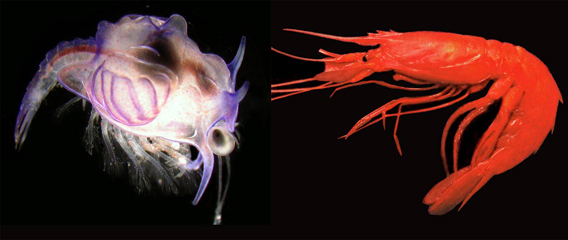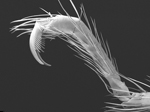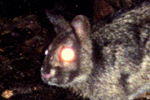
The larva known as Cerataspis monstrosa. Photo courtesy of Bracken-Grissom et al.
With blue devil-shaped horns and red armor, the monster larva, or Cerataspis monstrosa, kept scientists guessing for nearly 200 years; infrequently found in the bellies of marine predators, researchers could not imagine what this larva became as an adult. Now they do: the monster larva becomes a deep sea shrimp, known as Plesiopenaeus armatus, which bares little monstrous resemblance to its larval stage, according to DNA studies published in Ecology and Evolution.
Although tiny, lead author Heather Bracken-Grissom says that Cerataspis monstrosa has a “bizarre, monster-like appearance.” She adds, “It’s really crazy when you see it.” Sporting neon blue horns, what look-like backwards curving tusks, and reddish-purple armor, the larva looks like something out of science fiction.
“In the larval form, we think it has an extended existence in the water column because of its unusual physical characteristics,” Bracken-Grissom says in a press release. “We know that it’s a food source for some large, predatory fish. But there’s so much we just don’t know about it.”
Bracken-Girssom and her team took DNA from a well-persevered specimen of the larva found in 2009 and then linked it to the deep sea shrimp. The animal, both in its larva and adult stage, is rare and difficult for researchers to find. But at least now researchers know what it turns into when it grows up.
“There are so many instances where we have documented creatures in infant or larval stages and have no idea they become as adults. It’s just further evidence of how vast the oceans are,” Bracken-Grissom says, adding, “I hope this discovery helps keep the conversation going about the importance of biodiversity.”

Larva (left) becomes shrimp (right). Photo courtesy of Bracken-Grissom et al.
CITATION: Bracken-Grissom, H. D., Felder, D. L., Vollmer, N. L., Martin, J. W. and Crandall, K. A. (2012), Phylogenetics links monster larva to deep-sea shrimp. Ecology and Evolution. doi: 10.1002/ece3.347
Related articles
‘Penis-headed’ fish discovered in Vietnam
(08/27/2012) A bizarre penis-headed fish has been discovered in Vietnam, according to a new paper published in the journal Zootaxa.
Bizarre new rodent discovered in Indonesia has only 2 teeth

(08/22/2012) The Indonesian island of Sulawesi is a workshop of bizarre evolutionary experiments. Think of the babirusa, pig-like species with tusks that puncture their snouts; or the maleo, a ground-bird that lays its eggs in geothermal heated sand; or the anoa, the world’s smallest wild cattle. Now the island, made up of four intersecting peninsulas, can add another bizarre creature to its menagerie of marvels: the Paucidentomys vermidax, a new species of rodent that is different from all others.
Velociraptor spider discovered in Oregon cave (pictures)

(08/17/2012) Scouring the caves of Southwest Oregon, scientists have made the incredible discovery of a fearsome apex predator with massive, sickle claws. No, it’s not the Velociraptor from Jurassic Park: it’s a large spider that is so unique scientists were forced to create a new taxonomic family for it. This is the first new spider family to be discovered in North America in over 130 years. ‘This is something completely new,’ lead author of a paper on the species, Charles Griswold with the California Academy of Sciences, told SFGate. ‘It’s a historic event.’
King of the jungle: lions discovered in rainforests
(08/13/2012) Calling the African lion (Panthera leo) the ‘king of the jungle’ is usually a misnomer, as the species is almost always found in savannah or dry forests, but recent photos by the Germany-based Nature and Biodiversity Conservation Union (NABU) document lions in Ethiopian rainforests. Taken in the Kafa Biosphere Reserve, the photos show a female lion hiding out in thick montane jungle.
‘The lion of the cave:’ new predatory, swimming cricket discovered in Venezuela
(08/06/2012) Scientists have discovered what is likely a new species of cricket that is the top predator of its lightless world: a cave in a Venezuelan tepui. The fauna of cave was documented by BBC filmmakers as researchers uncovered not only a large, flesh-eating cricket but a new species of catfish.
Scientific expedition to survey species in China’s Bigfoot territory
(07/02/2012) This month, nearly 40 scientists will enter a wild and remote region of western China, reports China’s state media Xinhua. Spending several weeks in Shennongjia Nature Reserve, the researchers hope to study rare species like the golden snub-nosed monkey (Rhinopithecus roxellana), which is listed as Endangered by the IUCN Red List. But the forest is also the source of China’s ‘wild man’ sightings; known locally as the ‘Yeren,’ the unconfirmed primate has also been dubbed China’s Bigfoot.
Forgotten species: the overlooked Sumatran striped rabbit

(06/28/2012) When you read the words ‘Sumatra’ and ‘Endangered Species’ in the same sentence there is a 99 percent chance that you will be reading about one of four animals: orangutans, tigers, elephants, or rhinos. These big four of Sumatra have become the rallying cry to save the island’s ever-dwindling forests. This is not surprising, given that these species include some of the world’s most publicly beloved animals and, in addition, they are all considered Critically Endangered by the IUCN Red List. But by dominating the headlines in Sumatra’s deforestation crisis, these four species often overshadow the thousands of other species found on the island, many of which also face extinction. In fact when you read the words ‘Sumatra’ and ‘Endangered Species’ you will almost certainly not be reading about the Sumatran striped rabbit.